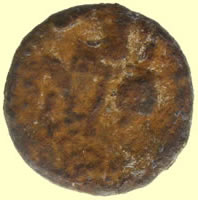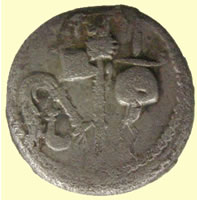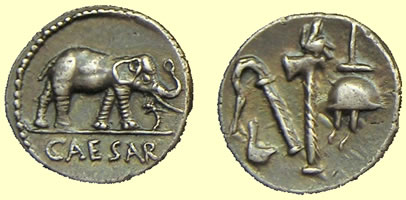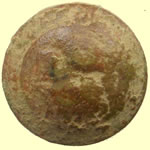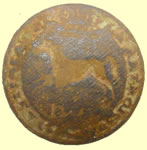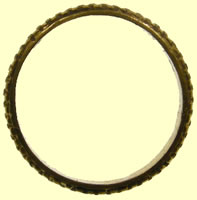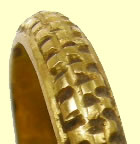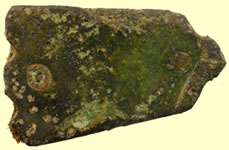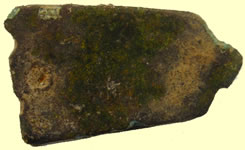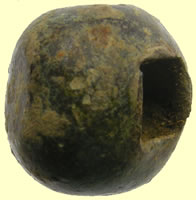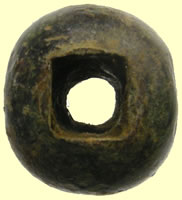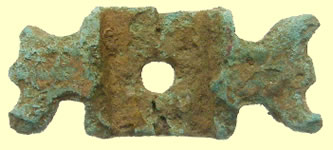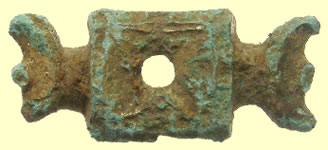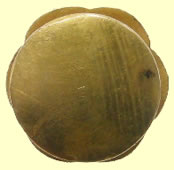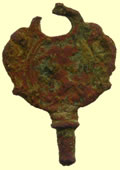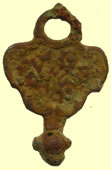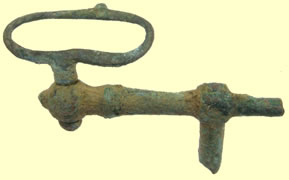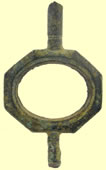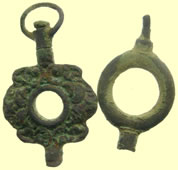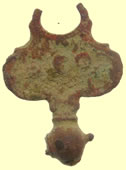

Metal detecting holidays in England with the World's most successful metal detecting club.
Twinned with Midwest Historical Research Society USA
| 2011 Oct finds page |
  |
 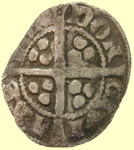 |
||
1272 Edward 1st hammered silver penny - Class 2 Obv EDWR ANGL DNS HYB Rev CIVI/TAS/EME/DV * - Durham mint - reverse die error |
1341 Edward III hammered silver penny - Cross 3- Florin type Obv EDWAR ANGL DNS HYB Rev CIVI/TAS/LON/DON - London mint |
||
  |
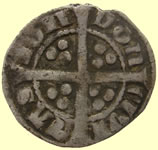 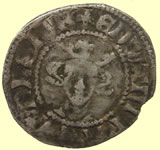 |
||
1341 Edward III hammered silver penny - Cross 3- Florin type Obv EDWAR ANGL DNS HYB Rev CIVI/TAS/CAN/TOR - Canterbury mint |
1361-69 Edward III hammered silver penny - Cross 2- Treaty Obv EDWARD ANGL R DNS HYB Rev CIVI/TAS/LON/DON - London mint |
||
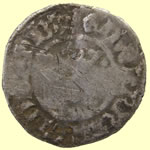 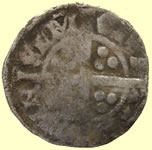 |
  |
||
1341 Edward III hammered silver penny - - Florin type Obv EDWAR ANGLE DNS HYB Rev CIVI/TAS/DVN/ELM - Durham mint |
1526-44 Henry VIII hammered silver groat - Arrow mintmark | ||
As dug
'cooking'
Mark sent me this pic MK 15 07 Vespasian, 69-79 AD.
|
|||
2ndC Roman silver coin - 'cooking' it to remove crust This is probably a Flavian (Vespasian, Titus or Domitian) but it is a similar reverse with sacrificial implementia. This one has "TRI POT" (Tribunicia Potestatum or the Tribunician Powers) across the bottom of the reverse, and that's a common reverse type for the Flavians. Other emperors used the sacrificial implements as a reverse type. So I can't be certain who it is until there's a bit more obverse detail to go on. I can tell you that they're often associated with issues for the Caesar - the "heir apparent" - (if there is one) so I'd make a guess there's a good chance this may be Titus, but I believe Vespasian used this same reverse. When you've revealed some obverse details I should be able to tell you better what you've got here. Mark
|
|||
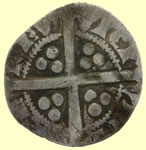 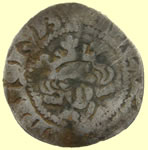 |
 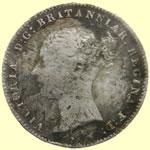 |
||
1296 Edward 1st hammered silver penny - - Class 2b Obv EDWR ANGL DNS HYB Rev VILL/ABE/REV/VICI - Berwick mint |
1845 Victoria milled silver 3 pence | ||
Size comparison with penny
|
|||
1431 32 Henry VI hammered silver farthing - Pine cone mascle issue Obv +HENRIC REX ANGL Rev CIVI/TAS/LON/DON - London mint 0.26g,9.74mm |
|||
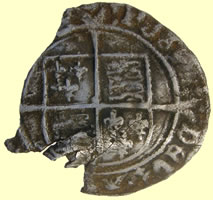 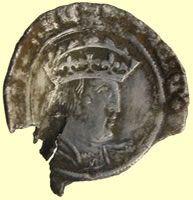 |
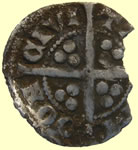 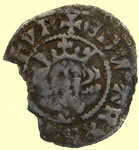 |
||
| 1526-44 Henry VIII hammered silver groat - Arrow mintmark | 1341 Edward III hammered silver penny - Cross 3- Florin Obv EDWAR ANGL R DNS HYB Rev CIVI/TAS/LON/DON - London mint |
||
 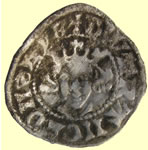 |
 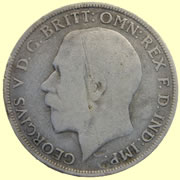 |
||
1341 Edward III hammered silver penny - Cross 3- Florin Obv EDWAR ANGL R DNS HYB Rev CIVI/TAS/CAN/TOR - Canterbury mint |
1921 George V milled silver florin 9 24 pence) | ||
  |
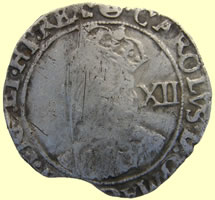 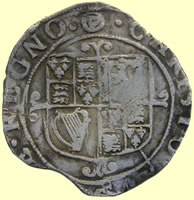 |
||
| 1920 George V milled silver sixpence | 1641-3 Charles 1st hammered silver shilling - Triangle in circle mintmark Tower mint under Charels 1st |
||
 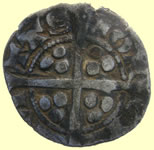 |
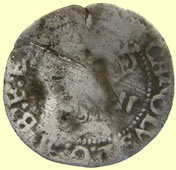 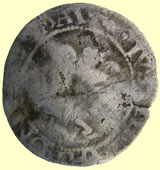 |
||
1272 Edward 1st hammered silver penny - Class 10 Obv EDWR R ANGL DNS HYB Rev CIVI/TAS/LON/DON - London mint |
Charles 1st Aberystwyth - Furnance mint 1648/9 hammered silver half groat - Large plume - book mintmark |
||
 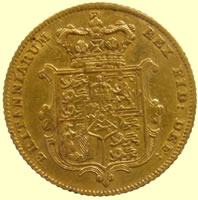 |
|||
| Very crisp 1827 George IV milled gold half sovereign | |||
 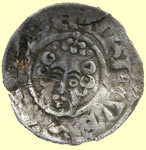 |
|||
1216 Henry III hammered silver short cross penny Class 7a - top bar to A Obv HENRICVS REX Rev NORMAN ON S*** Moneyer Norman of Bury St Edmunds mint |
|||
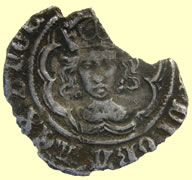  |
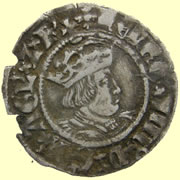 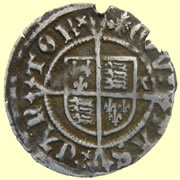 |
||
1485 Henry VII hammered silver half groat - Two arches jewelled to crown - Type 3 Rev CIVI/TAS/CAN/TOR - Canterbury mint |
1526-32 Henry VIII hammered silver half groat - Cross patonce mintmark Archbishop Warham - WA by shield Rev CIVI/TAS/CAN/TOR - Canterbury mint |
||
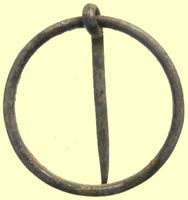 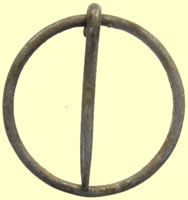 |
|||
| Stunning medieval silver annullar brooch - reported to museum as treasure | |||
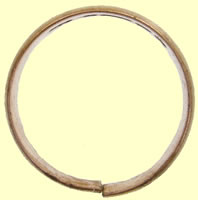 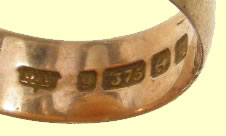 |
 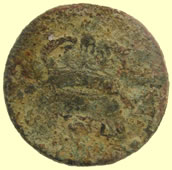 |
||
1915 - 9 Carat gold ring - Birmingham date letter q - Maker RP Robert Pringle & Sons |
1604 James 1st gold guinea coin weight | ||
 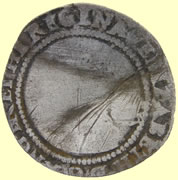 |
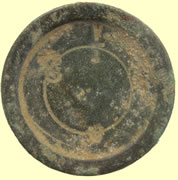 |
 |
|
| 1567 Elizabeth 1st hammered silver sixpence | George III trade weight - Crown G cipher London | 19thC livery button | |
 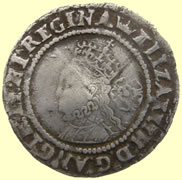 |
 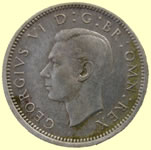 |
||
| 1567 Elizabeth 1st hammered silver sixpence | 1945 George VI milled silver sixpence | ||
 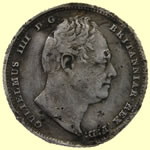 |
 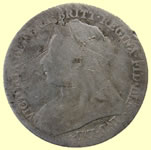 |
||
| 1835 William IV milled silver sixpence | 1900 Victoria milled silver sixpence | ||
 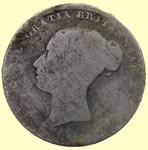 |
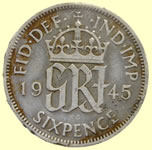 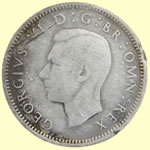 |
||
| 1844 Victoria milled silver sixpence | 1945 George VI milled silver sixpence | ||
  |
 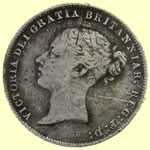 |
||
| Alexander II 1214-49 Scottish hammerd penny - needs straightening to ID properly | 1867 Victoria milled silver sixpence67 | ||
As dug and partially 'cooked' sent for ID |
|||
1stC Roman coin - straight into 'cooker' to clean off crust
What you have here is a denarius of Trajan, 96-117 AD. It was during Trajan's time that the Roman Empire achieved it greatest overall size - it would never again be so large. Although Hadrian and others of Trajan's successors were quick to lop-off some of the further flung and less easily administered and defended areas, Trajan's rule ushered-in the era of "The Good Emperors" The 2nd century, therefore, was noted for a general condition of relative peace and prosperity the likes of which would not be seen again (arguably, even in our own time). This specific piece has "Genius" (Genio Populi Romani - the genius or motivating spirit of the Roman People) standing left holding a patera - a sacrificial vessel for pouring libations - and a cornucopiae. The legend on the reverse, as is often the case on Trajan's coins, cites only "The Senate and The People of Rome" and the statement that Trajan was "The Optimum Prince". The obverse legend (which is somewhat unclear on your specimen, so far) will be the typical 2nd century "laundry list" of titles: IMP TRAIANO AVG GER DAC P M TR P COS V P P. The catalog references for this piece are: RIC II 181; RSC 395. 107 AD Mark
|
|||
 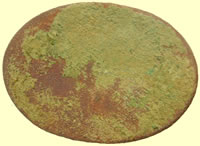 |
 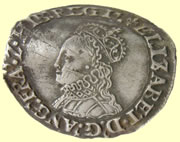 |
||
| 19thC Billingsgate Fish market London trade token - James Howell | 1558-60 Elizabeth 1st hammered silver sixpence - 1st issue Lis mint mark | ||
|
  |
||
| 16thC Tudor S buckle | Stunning enamelled 13thC medieval pendant | ||
 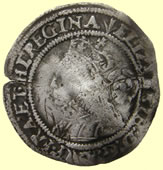 |
 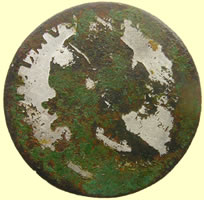 |
||
| 1561 Elizabeth 1st hammered silver three pence - Pheon mintmark | 1696 William III milled silver half crown (30 pence) forgery | ||
  |
 |
||
| 1696 William III milled silver sixpence - Bristol mint | Georgian gold watch winder | ||
 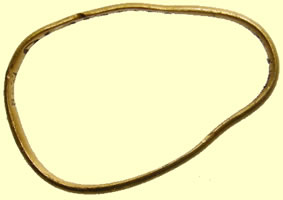 |
|||
| 22 carat 1852 Victorian bust mark London hallmarked gold ring | |||
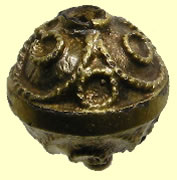 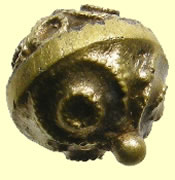  |
|||
| Stunning gold 16thC Tudor pin head - reported to museum as treasure | |||
  |
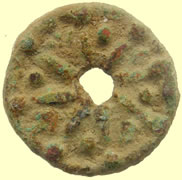 |
 |
|
A cast copper alloy mount of probable Post-Medieval date (1500-1700 AD). Broad period: POST MEDIEVAL Date from: AD 1500 |
Medieval mount | Victoria Royal Engineers button | |
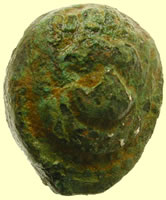 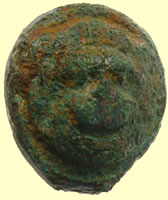 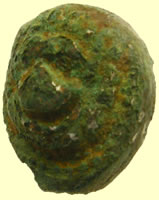 |
|||
| Roman animal headed mount - gilding remains | |||
 |
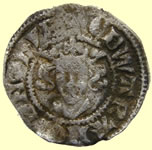 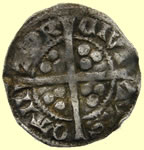 |
||
| 18thC toy cannon | 1341 Edward III hammered silver penny - Florin Obv EDWAR ANGL DNS HYB Rev CIVI/TAS/CAN/TOR - Canterbury mint |
||
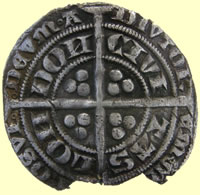  |
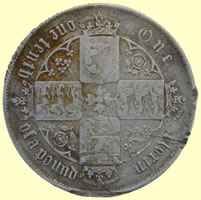 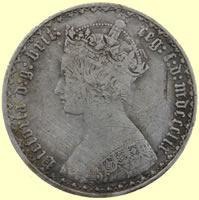 |
||
| 1351-2 Edward III hammered silver groat - Cross 1 - Letters C & E open Obv EDWARD D.G. REX ANGL Z FRANCE D HYB Rev CIVI/TAS/LON/DON - London mint
|
1859 Victoria milled silver Florin (24 pence) mdccclix |
||
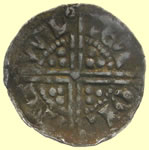 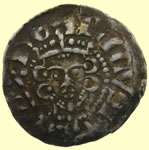 |
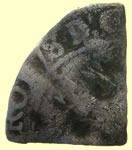 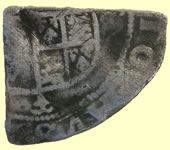 |
||
1247 Henry III hammered silver voided long cross - Class 5b Obv HENRICVS REX Rev WIL/LEM/ONC/ANT Moneyer Willem of Canterbury |
First qtr'd 1634 Charles 1st hammered silver shilling (12 pence) I have seen Obv **ROLVS D G (Carolvs)
|
||
 |
  |
||
| Exploded 18thC toy cannon | Medieval copper alloy belt mountChronologyBroad period: MEDIEVAL Date from: AD 1100 |
||
 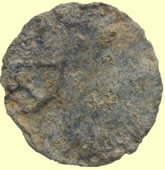 |
 |
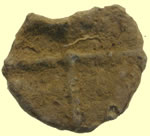 |
|
| 17thC lead token | 19thC Dragoons guards button | 15thC lead token type 2 | |
 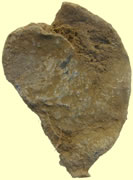 |
 |
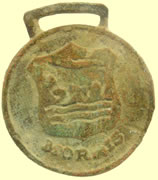 |
|
17thC Thomas Reynolds bay maker of Colchester lead seal |
RN Capt / Commander - 1787 RN Lieutenant - 1787 |
20th C 120th Air Training service key fob | |
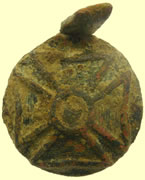 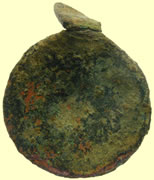 |
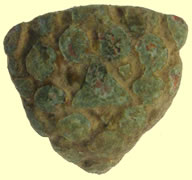 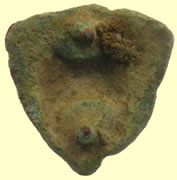 |
||
| 17thC mount | Medieval mount | ||
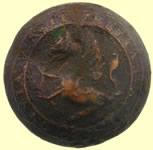 |
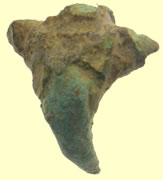 |
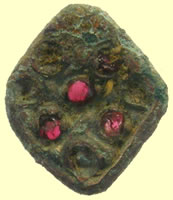 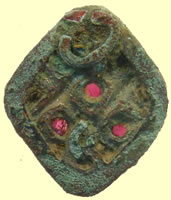 |
|
| 19thC livery button | 2ndC Roman fibular brooch | Medieval pendant with glass stones and gilding remaining | |
 |
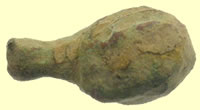 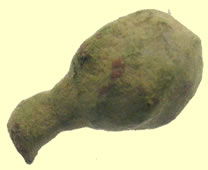 |
||
| Medieval pin head | 17thC pin head | ||
|
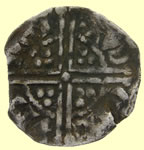 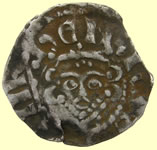 |
||
| 1700 William III milled silver four pence | 1247 Henry III voided long hammered silver penny - Class Vg Obv HENRICVS III Rev REN/AVD/ONL/VND - Renavd of London mint |
||
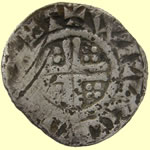 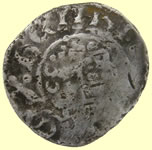 |
  |
||
1217 Henry III hamered silver short cross penny Class 7 Obv HENRICVS REX Rev +WILLEM ** CANT - Moneyer Willem of Canterbury mint |
Taco'd 13thC hammered silver penny - need straightening to ID properly | ||
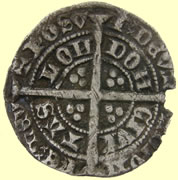  |
 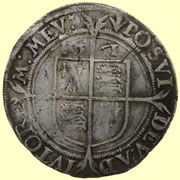 |
||
1361-1369 Edward III hammered silver groat - Cross potent - Treaty B - double annulet and satire stops - Normal N's Obv EDWARDVS REX ANGL DNS HYB HYB Rev CIVI/TAS/LON/DON - London mint |
1561 Elizabethy 1st hammered silver sixpence | ||
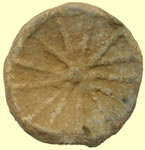 |
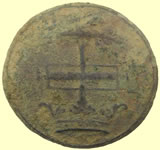 |
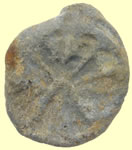 |
 |
| 15thC lead token | 19thC livery button | 15thC lead token | WWII Civil defence button |
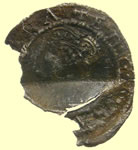 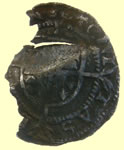 |
 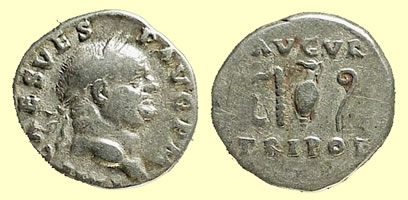 |
||
| 1560-1 Elizabeth 1st hammered silver penny | You're correct that this coin has a Shewolf & Twins reverse which is typically found on the VRBS ROMA, City of Rome commemorative, reduced-module folles introduced around 330 AD., at the time Constantinople became the official seat of Constantine's government. These have a helmeted and mantled bust of the allegorical personification of the City of Rome facing left on their obverses. At approximately 17mm (although at 1.41gm, it's on the light side) it's most likely from the emissions of c 330-333/5, rather than the later ones of 333/5-337 which tended to be even smaller. At some mints, they were even continued as a type past the death of Constantine in 337, although often paired with a "Vota" or a GLORIA EXERCITVS soldiers & standard reverse rather than the wolf & twins. This atypical use of a subject other than an Imperial bust on the obverse was a convenient political "dodge" for cities which hadn't necessarily declared-for or been brought securely into the fold of one or another of Constantine's sons, who had some "disagreement" about who had inherited what territory or was to rule where, etc.
h-tips of a few letters are visible, but not enough to really be able to tell what was intended.
For a somewhat clearer view of the type, see: http://www.stoa.org/gallery/album165/52_VRBS_CYZ or: http://www.stoa.org/gallery/album165/57_VRBS_TES and as you can see from the first example, these were originally silver-washed, although the silvering very seldom survives to the present day.
Mark |
||
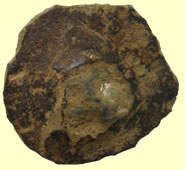 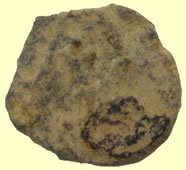 |
  |
||
| Mid 4thC Roman bronze coin | 1634 Charles 1st hammered copper rose farthing | ||
 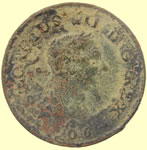 |
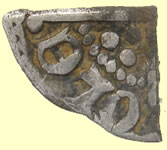 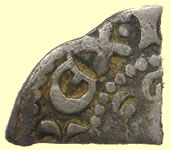 |
||
| 1816 George III copper farthing | 1247 Henry III voided long cross hammered silver penny Moneyer Nicole |
||
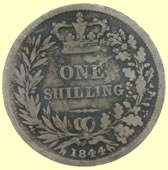 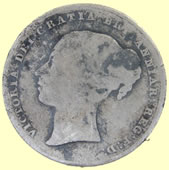 |
 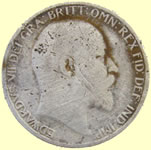 |
||
| 1844 Victoria milled silver shilling (12 pence) | 1902 Edward VII milled silver sixpence | ||
|
|||
Very unusuall BC Republican Roman silver coin - straight into the 'cooker' but there is enough detail sol I have sent it off to Mark Lehman for his views before I clean it up
SILVER Denarius - 49 to 44 BC, Obv Elephant Rev Bird facing left Mitch Chris posted on the forum a picture and ID of the coin and it appears to match. that's a Julius Caesar elephant denarius. The elephant is walking right trampling either a serpent (not too likely, but possible) or a Celtic Carnyx - a war trumpet in the shape of a serpent or dragon - in the generous exergue below, you have CAESAR in large, clear letters no one could mistake. The reverse is an assortment of priestly implements - the exact order and assortment may vary from issue to issue, but will include various items from this list: simpuulum (ladle), aspergillum (sprinkler - looks like a hand-sized floor-mop) jug, knife, axe, apex (pontifex's special hat) and lituus (curved wand). Caesar held the post of Pontifex Maximus from an early age, which despite its odd set of restrictions, allowed him entry into the halls of power and was his launching-pad to greatness. The type dates to 49 BC, or about the time his political career in Rome really hit stride, 5 years or so before his demise. I believe this was well after his abortive attempts at conquering Britain, although I'm not all that certain about the time-line here. It was a prolific issue and is really relatively common, so it's not too exceptional for one to have made it to Britain in the course of trade, or even been carried by one of Claudius' soldiers as a talisman - although it wasn't impossible for denarii to stay in circulation for a century at that time, this seems to have enough detail to be fairly bold even under encrustation - ie: it doesn't exhibit anything like the wear one would expect for a coin which had circulated for 100 years. Here's an example showing all the details clearly http://www.stoa.org/gallery/album434/MK_15_04 Mark
|
|||
 |
 |
||
| 17thC clothing fastener | |||
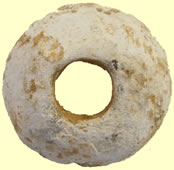 |
 |
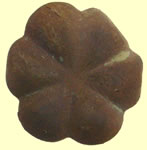 |
 |
| Roman spindle whorl | WWII Royal artillery badge | A Late Medieval/ Early Post-Medieval (15th-early 16th century) cast one-piece copper-alloy mount, convex and cinquefoil in shape Broad period: MEDIEVAL Period to: POST MEDIEVAL Date from: AD 1400 |
RN Capt / Commander - 1787 RN Lieutenant - 1787 |
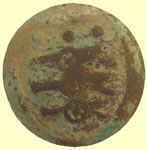 |
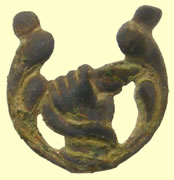 |
  |
|
| 1790 Royal artillery button | Georgian brooch | 1818 George III milled silver sixpence | |
| Georgian watch winders - and two complete with lever | |||
  |
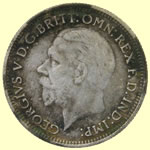  |
||
| 1914 George V milled silver florin (24 pence) | 1935 George V milled silver sixpence | ||
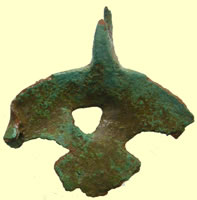 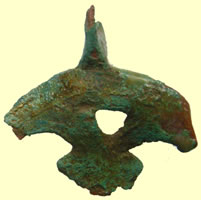 |
 |
||
| C8thC Saxon harness gilded pendant | c10thC Saxon harness cheek piece | ||
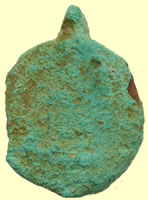 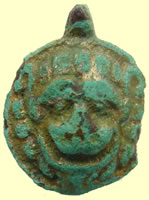 |
|||
| C8thC Saxon gilded pendant | |||
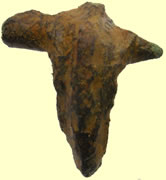 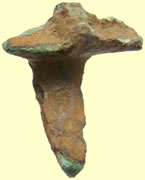 |
  |
||
| 2ndC Fibular brooch | 1846 Victoria milled silver four pence | ||
 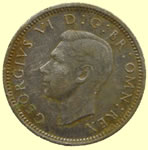 |
  |
||
| 1939 George V milled silver sixpence | 18thC bullion cup weight | ||
 |
 |
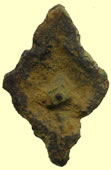 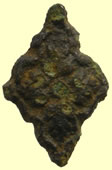 |
|
| Medieval key handle | Lead goose with bowler hat ? | Medieval mount with single integral lug | |
 |
 |
 |
|
| 19thC Harwich Light Cavalry button | 1890 General service army button | UNITED KINGDOM Royal London Yacht Club R. T. Y. C. - R. T. Y. C. London, England In use 1837 - 1901 |
2- 5th Dragoons guards buttons - Crimean war period - unrecorded in any ref book |
 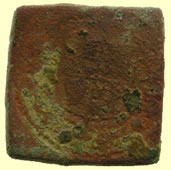 |
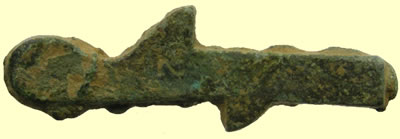 |
||
| 1604 James 1st gold coin weight | Lock internal mechanism arm- not sure of date as it is marked '2' | ||
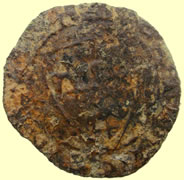 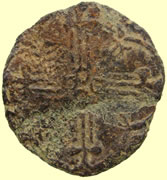 |
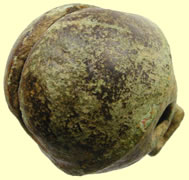 |
 |
|
French copper- alloy Jeton 1380AD Obv Shield of France bearing three feur de lys Rev trefoil x 4 Ottery St Mary |
18thC crotal bell | 19thC VR - Victoria Rex -Dragoon guards button | |
 |
 |
||
| 17thC sword belt fitting | Medieval spur | ||
|
|||
| 15th/16thC gold ring -reported to museum as treasure - no hallmarks
18.71mm, 1.05g |
|||
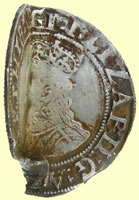 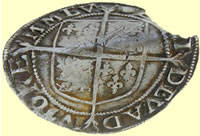 |
  |
||
1592-5 Elizabeth 1st hammered silver shilling (12 pence) Tun mintmark - sixth issue 31.61mm dia |
1247 Henry III hammered silver voided penny Rev HEN/RIO/NLV/VND Henri of London mint |
||
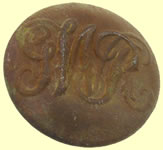 |
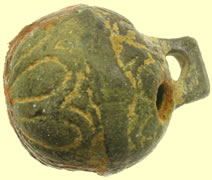 |
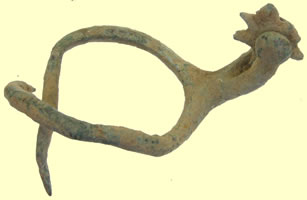 |
|
| Great Western Railways button | 17thC crotal bell | Medieval spur with rowell still attached | |
 |
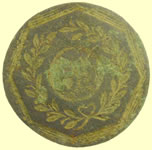 |
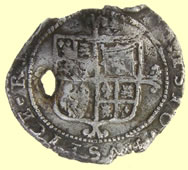 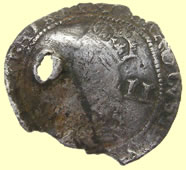 |
|
| Georgian bell trade weight | 19thC 55th Regiment of foot button | 1634 Charles 1st hammered silver half groat | |
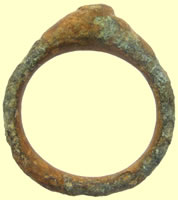 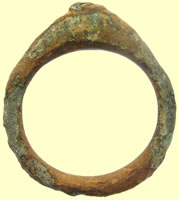 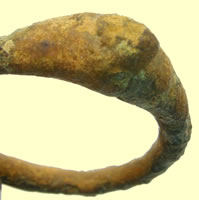 |
|||
| Medieval bronze 'stirrup' type finger ring | |||
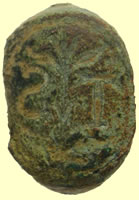 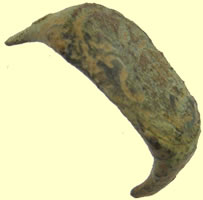 |
 |
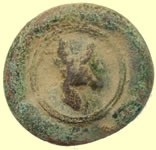 |
|
| Medieval traders seal ring (IS) | 18thC clog fastner | 19thC hunting button | |
 |
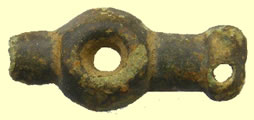 |
|
|
| 19thC London Docklands button | Medieval mount | Medieval strap end | |
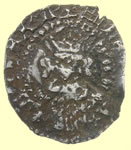 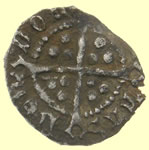 |
 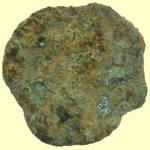 |
||
1509-26 Henry VIII hammered silver half penny Portcullis Crowned mint mark - 1st issue Obv HENRIC DI GRA REX AGL Rev CIVI/TAS/LON/DON - London mint |
Mid 4thC Barabarous radiate Roman bronze coin | ||
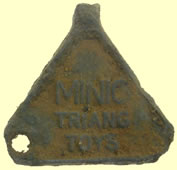 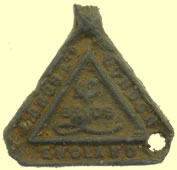 |
 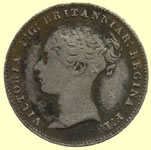 |
||
| Triang Toys key | 1844 Victoria milled silver three pence | ||
 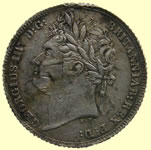 |
|
||
| 1821 George IV milled silver sixpence | Post medieval dagger pommel | ||
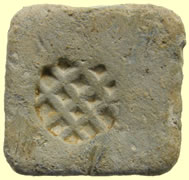 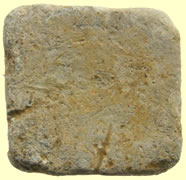 |
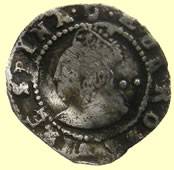 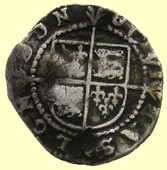 |
||
| 16thC lead trade weight | 1587-9 Elizabeth 1st hammered silver half groat | ||
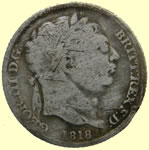 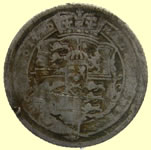 |
 |
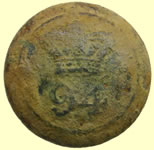 |
|
| 1818 George III milled silver sixpence | Georgian buckle | 94th regiment of foot O/R's (Brass) - 1802-1881 |
|
 |
 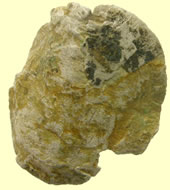 |
||
| 18thC toy cannon | 18thC German billion silver coin | ||
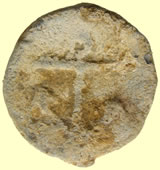 |
 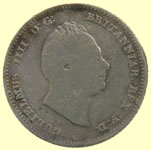 |
||
| 17thC lead token | 1836 William IV milled silver four pence | ||
 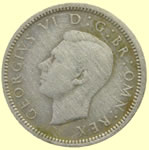 |
 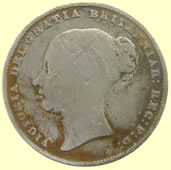 |
||
| 1944 George VI milled silver sixpence | 1859 Victoria milled silver sixpence | ||
  |
 |
||
| 1916 George V milled silver sixpence | 20thC Whistle | ||
 |
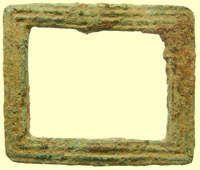 |
 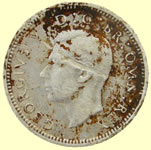 |
|
| Victorian silver cufflink | Georgian buckle | 1943 George VI milled silver sixpence | |
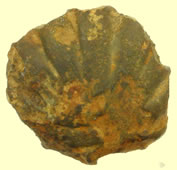 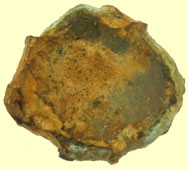 |
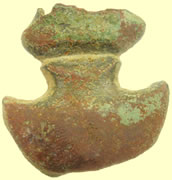  |
||
| Roman mount | Broad period: POST A cast copper alloy mount of probable Post-Medieval date (1500-1700 AD). MEDIEVAL Date from: AD 1500 |
||
 |
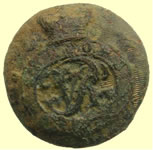 |
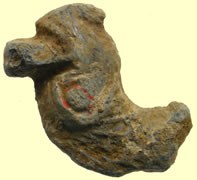 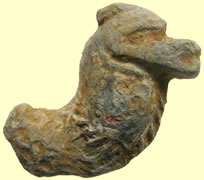 |
|
| Post medieval lead hanging weight | 19thC Victoria Engineer Corp button | Medieval mount with red enamelling remaining | |
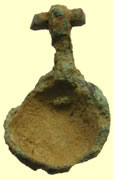 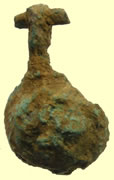 |
 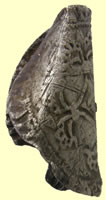 |
||
| Roman pendant with face decoration | 1475 Dutch -Karel de Stoute -silver DOUBLE STUIVER |
||
 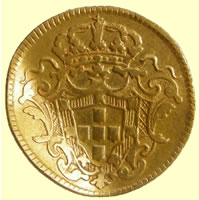 |
|||
1728 Portuguese Joao V milled gold - 1/2 Escudo (800 Reis) 0.9170 Gold John V of Portugal
|
|||
|
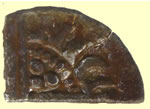 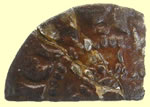 |
||
1215 Henry III hammered silver short cross penny Obv HENRICVS Rev *VD +RA *** Moneyer Ravlf of London mint |
1247 Henry III hammered silver voided long cross qtr penny | ||
 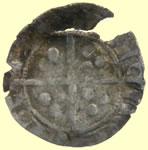 |
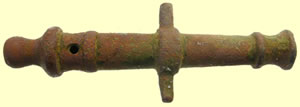 |
||
1351-1361 Edward III hammered silver penny - Pre treaty Obv EDWR ANGL DNS HYB Rev DVR/REM * - Durham mint |
18thC toy cannon | ||
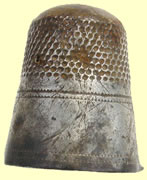 |
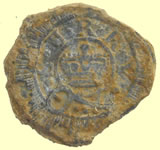 |
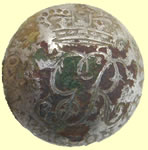 |
|
| 19thC silver thimble | 18thC Surry regiment pewter button | Excellent button find - 19thC GR 'Royal Waggon Train' |
|
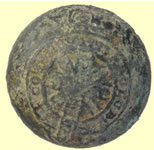 |
 |
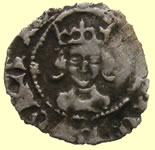 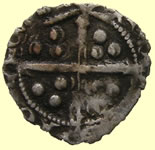 |
|
| 19thC Colchester club button | 19thC corporation button | 1485 Henry VII hammered silver farthing - double arched crown Obv CIVI/TAS/EBO /RACI -York mint |
|
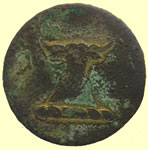 |
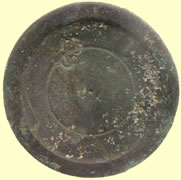 |
 |
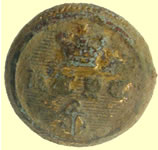 |
| 19thC livery button | George 1st trade weight - crown G cipher | 19thC livery button | UNITED KINGDOM Royal London Yacht Club R. T. Y. C. - R. T. Y. C. London, England In use 1837 - 1901 |
|
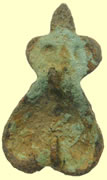 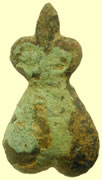 |
||
| Roman gilded mount | A cast copper alloy mount dating to the seventeenth century AD.ChronologyBroad period: POST MEDIEVAL Date from: Post AD 1600 |
||
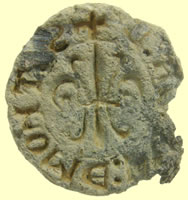 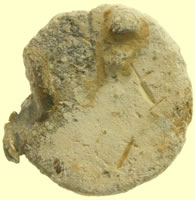 |
|||
1260 AD Non Heraldic personal seal. The design is typical of mid 13thC non heraldic seals |
|||
|
 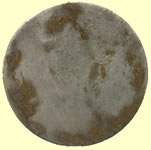 |
||
| Georgian gold collar studd | 19thC Victorian milled silver sixpence | ||
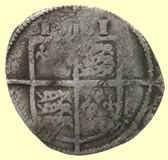  |
 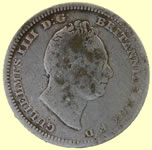 |
||
| 1561 Elizabeth 1st hammered silver 3 pence | 1837 William IV milled silver four pence | ||
 |
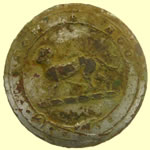 |
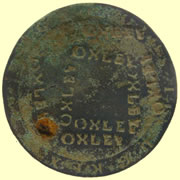 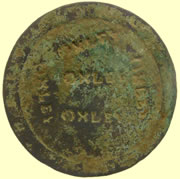 |
|
| 19thC Great Eastern Railways and Steam ships company button | 19thC livery button | 1797 George III cartwheel penny overstamped Oxley | |
|
|||
| Lots of Georgian watch winders being dug | |||
 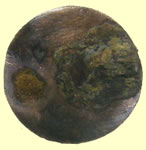 |
 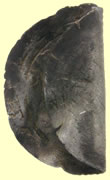 |
||
| Gold plated Edwardian button | Taco'd 1554 Mary hammered silver groat | ||
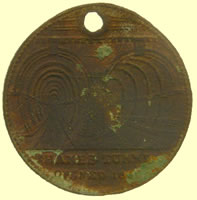 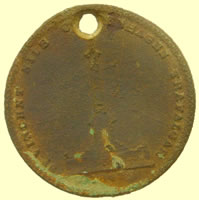 |
|||
The Thames Tunnel is an underwater tunnel, built beneath the River Thames in London and connecting Rotherhithe with Wapping. It measures 35 feet wide by 20 feet high and is 1,300 feet long, running at a depth of 75 feet below the river's surface at high tide. It was the first tunnel known successfully to have been constructed underneath a navigable river, and was built between 1825 and 1843 using Thomas Cochrane and Marc Isambard Brunel's newly invented tunnelling shield technology, by him and his son Isambard Kingdom Brunel. |
|||
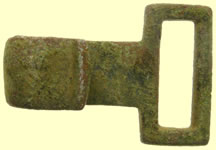 |
 |
 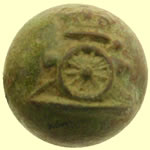 |
|
| 17thC sword hanger | 17thC clothing fastener | Royal artillery button | |
 |
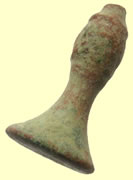 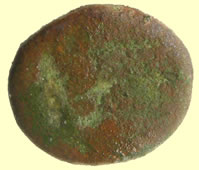 |
||
| 18thC musket ramrod guide | 16thC Tudor seal spoon handle - AE | ||
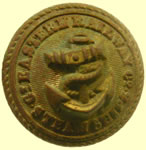 |
 |
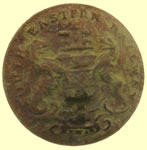 |
 |
| 19thC Great Eastern Railways and Steam ships company button | Georgain barrel tap key | 19thC South Eastern railways button | A Late Medieval/ Early Post-Medieval (15th-early 16th century) cast one-piece copper-alloy mount, convex and cinquefoil in shape Broad period: MEDIEVAL Period to: POST MEDIEVAL Date from: AD 1400 |
 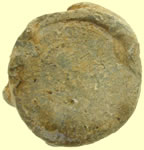 |
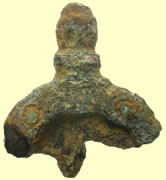 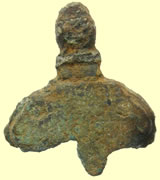 |
||
| Post medeival lead bale seal | Roman hanging pendant - circule design | ||
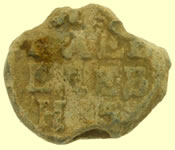 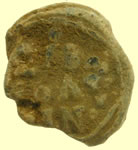 |
  |
||
| 19thC Russian lead bale seal | 17thC pendant | ||
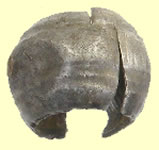 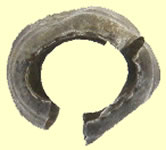 |
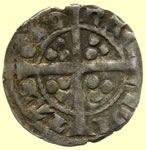  |
||
| Victorian silver band | 1272 Edward 1st hammered silver penny Obv EDWR ANGL DNS HYB Rev CIVI/TAS/CAN/TOR - Canterbury mint |
||
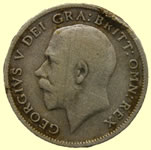 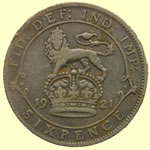 |
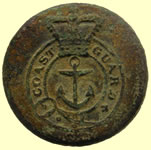 |
 |
|
| 1921 George V milled silver ixpence | 19thC coast guard button | Medieval lead bale seal | |
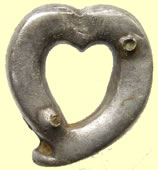 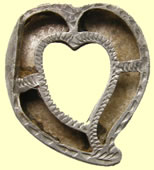 |
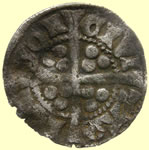  |
||
| Victorian silver brooch | 1272 Edward 1st hammered silver penny Obv EDWR R ANGL DNS HYB Rev CIVI/TAS/LON/DON - London mint
|
||
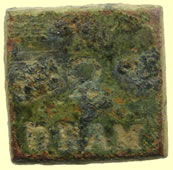 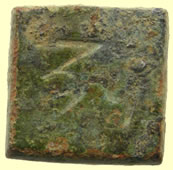 |
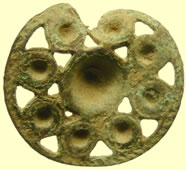 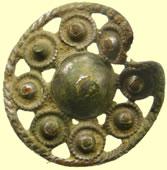 |
||
| 18thC 2 dram apothecary weight | Georgian mount | ||
 |
 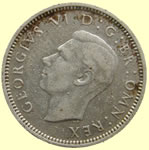 |
||
| J.Caster of Harwich advertising watch winder | 1943 George V milled silver sixpence | ||
  |
 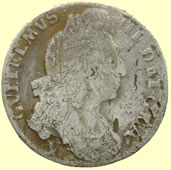 |
||
| 1940 George V milled silver sixpence | 1696 William III milled silver sixpence | ||
  |
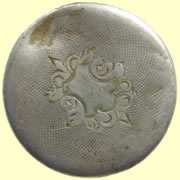 |
||
| 1247 Henry III hammered silver voided half penny | Victorian silver watch back | ||
 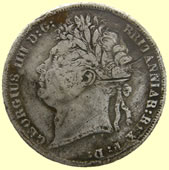 |
 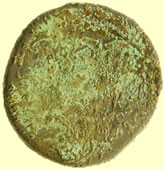 |
||
| 1824 George V milled silver shilling | East India company coin weight | ||
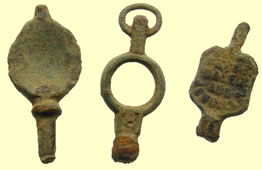 |
 |
||
| Georgian watch winders | Army spoon handle ? | ||
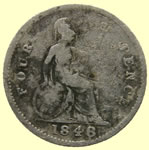 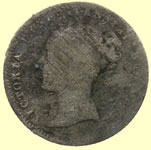 |
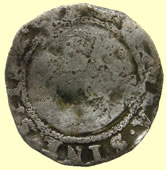 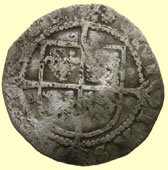 |
||
| 1846 Victoria milled silver 4 pence | 1565 Elizabeth 1st hammered silver half groat | ||
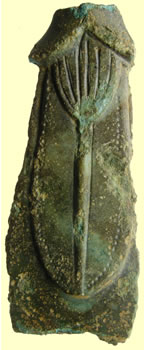  |
|||
| Huge bronze decorated handle - Late Iron Age patina | |||
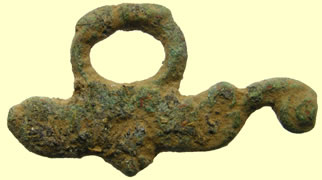 |
 |
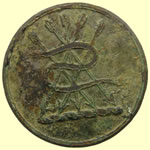 |
|
| 16thC Tudor purse bar | Huge Crown mount | 19thC livery button | |
More finds posted to Nov 2011 finds page
|
|||
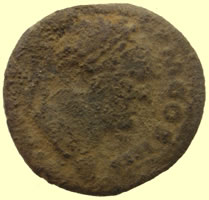
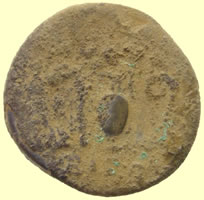
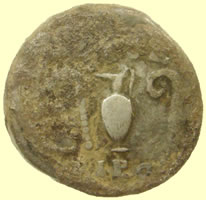
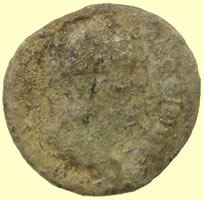
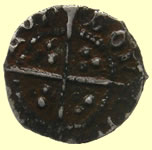
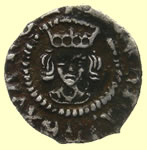
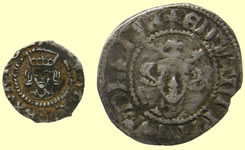



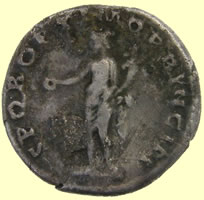
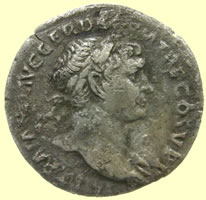
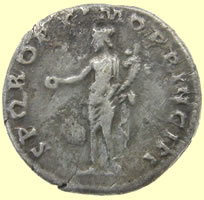
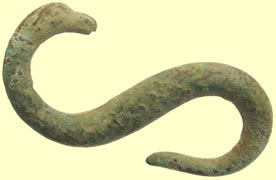
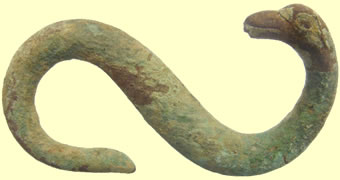

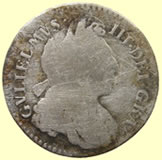 17
17